|
For many a visit to the Monastery of St. Katherine, the oldest continuously inhabited monastery in the world and a UNESCO world heritage site, at the foot of Mount Sinai is a must.
The monastery was built in the 6th century by the Byzantine emperor Justin, but in the year 330 the Empress Helena already built a church at the place where God spoke to Moses through the burning bush. This area is sacred to all monotheistic religions (Judaism, Christianity and Islam). The first Byzantine Orthodox monks were here before the year 330 and the monks still live according to the tradition of the early Christian monastic order, the spirituality of the desert (because life in the desert is tough, one may find God here).
The Orthodox monastic life is stern. The monks are fasting 3 days a week by just eating vegetables cooked in water. They get up at 4:00 AM and pray in their cells until 8:00 AM. From 8:00 to 9:00 AM there is a resting period and then each monk begins the task assigned to him (the library, the garden, cleaning icons, etc.). The first meal is lunch at 1:00 PM which all monks use in silence while a novice reads religious texts. From 13:30 to 15:00 PM there is a resting period, after which vesper service will be held until 17:00 PM and the monks return to their cubicle. At 22:00 PM the lights are extinguished, however the monks are allowed to read in their monastery cells by candlelight.
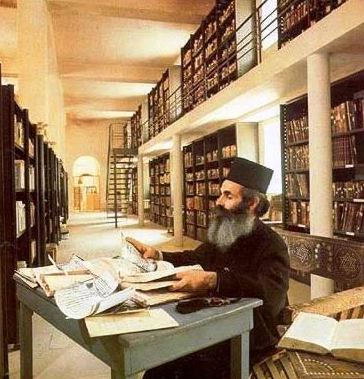 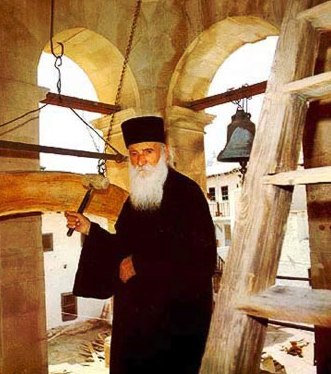
Monk at work in the library Monk rings the bell
The library was built between 1930 and 1942 and is a spacious, well-built, fire-resistant concrete wing of more than 10 meter wide and 15 meter long. Here one can find the biggest and most important religious collection, apart from the Vatican. It contains more than 6000 pieces from which 3000 are ancient Greek, Arabic, Syrian (Codex Syriacus), Armenian, Gregorian, Coptic, Polish and Slavic.
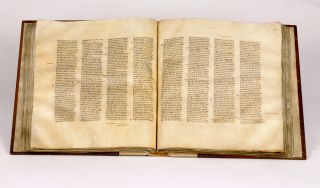 The Codex Sinaiticus, the book of the Sinai The Codex Sinaiticus, the book of the Sinai
(named after this monastery on Mount Sinai) is a manuscript of the Bible from the 4th century (like the Codex Vaticanus) and contains 400 pages with half of the Old Testament (the first part is lost), the entire New Testament (only the order of the writings is remarkably different) and two older writings (one of the Apostle Barnabas and one of the Roman writer Heras from the 2nd century) which are not included in the modern Bible. In the original text of the Codex there are many notes and changes from the first proof-readers. The ability and skill in itself to place these authoritative writings (roles of animal skin) in one (papyrus) book, influenced the way Christians thought about their books. The technique of bookbinding is today still done according to this principle. It is important to reconstruct the original text and the history of the Bible. The book of Sinai was well preserved for many centuries in the monastery until Constantine von Tischendorf took away pages and chapters in 1844, 1853 and 1859, with the intent to publish them. He donated the manuscript in 1933 to the Russian Tsar Alexander II. The Russian government later sold this to the BritishMuseum. Furthermore there are 43 pages in the university library in Leipzig. Also there are parts of six pages and 40 fragments stored in the National Library of St. Petersburg. In the monastery of St. Katherine there are now still 12 pages and 40 fragments, which were discovered in 1975 by monks. Since 2005, these 4 institutions work together to preserve, digitize, write down and publish everything that is left of the Codex Sinaiticus.
The icons collection (over 2000) of the monastery is the most important collection in the world, including 150 unique icons dating from the 5th to 7th century. The icons gallery can be viewed after an entrance fee is paid. These icons have survived the icon storm (726 to 843) in this remote monastery, while in the rest of the world during this period all representations of religious figures were removed or destroyed. The monastery contains unique sacred objects in the form of mosaics, frescoes, icons, manuscripts, engravings, gold embroidery, forging and woodwork, etc. from around the world.
Many senior leaders have over the years brought gifts to the monastery of Saint Katherine. The icon gallery is open to visitors on payment of an entrance fee.
The monastery was under the protection of Emperor Justinian and the Prophet Muhammad (pbuh), Arab leaders, Turkish leaders, Napoleon and it always was and still is protected by the Bedouins of Sinai so it has remained virtually intact. Within the walls of the monastery one finds a mosque next to the church, which is a rarity today.
Ahtiname is the Letter of protection of Prophet Muhammad (pbuh) for the rights of Christians and as a means of ensuring peaceful and cooperative relations between Christians and Muslims. The patent was granted to this holy monastery of Sinai. Ahtiname is derived from the Arabic words Ahd (obligation) and Name (document, testament).
 "This is a message from Muhammad ibn Abdullah, as a covenant with those who accept Christianity, near and far, we are with them. Verily I, the servants, the helpers, and my followers defend them, because Christians are my citizens/my people, and by Allah!, I fly out at anything that displeases them. There will be no compulsion for them. Neither are their judges to be removed from their position nor their monks from their monasteries. "This is a message from Muhammad ibn Abdullah, as a covenant with those who accept Christianity, near and far, we are with them. Verily I, the servants, the helpers, and my followers defend them, because Christians are my citizens/my people, and by Allah!, I fly out at anything that displeases them. There will be no compulsion for them. Neither are their judges to be removed from their position nor their monks from their monasteries.
Nobody will destroy a house of their religion, to damage or take anything out for the homes of Muslims. If anybody does, then he violates God's convention and he does not obey His Prophet. Indeed, they are my allies and have my charter against all that they hate. Nobody will force them to travel or oblige them to fight. The Muslims will fight for them. If a female Christian will marry a Muslim, this will not happen without her consent. She will not be prevented from visiting her church to pray. Their churches will be respected. They can not be bothered to repair it or their holy scriptures. None of the nation (Muslims) should disobey this Charter until the last day (the end of the world)."
The original letter was removed by the Turkish Sultan Selim I in 1517 (the monks were given a copy) and it is now in the Topkapi Museum in Istanbul. It secures the peaceful and friendly relations of cooperation between Christians and Muslims.
Saint Katherine, the patron saint of the monastery, was born as the daughter of the governor of Alexandria in the year 294. She studied philosophy, rhetoric, poetry, music, mathematics, astronomy and medicine. She was famous for her unparalleled beauty and intelligence, but she dismissed all wedding requests. Her mother, secretly a Christian, sent her for advice to her own spiritual father, an elderly recluse. This led to her conversion to Christianity, by which she saw Christ as her bridegroom, the great love of her soul.
In the early 4th century, during the persecution of Christians by Emperor Maxentius, she condemned the worship of pagan gods and bringing human sacrifices, mostly Christians. The emperor called the 50 highest persons in the realm of scholars, to convince her but her arguments for Christianity were so brilliant and its condemnation of paganism was so devastating that also these scholars converted to Christianity. By order of the emperor, the 50 converted scholars were burned but the now imprisoned Katherine bravely resisted any promises, threats and torture of the emperor.
Empress Augusta heard of Katherine and visited her with a senior military escort in prison. The empress was impressed by the strong spirit of Katherine, who taught the newcomers in the teachings of Christianity, to which they converted. The next day Katherine was again on trial. She would be broken on the wheel if she would not abandon her faith and did sacrifice to the pagan gods. Katherine began to pray and went to the wheel herself on which the instrument of torture burst into pieces. The Empress and her senior military with 200 soldiers saw this miracle and professed their faith on the spot, in front of everyone. They were all beheaded.
The emperor tried to seduce Katherine by asking her again to marry him but he was again rejected. She confessed her fidelity to her heavenly bridegroom Christ and while she prayed to Him she put her head on the block under the sword of the executioner.
Three centuries later, monks (led by a revelation in a dream) found on the mountain which later was called Mount Katherine, her remains that spread the sweet smell of myrrh. They brought them honourable to the monastery, where they were placed in a golden coffin. The skull and her left hand are in the basilica, where they continue to give a sweet smell and achieve miracles today.
The respectability of Katherine spread to the West, especially after the early 11th century. The many pilgrims who visited the monastery from that time led to the change of the name The Holy Monastery of Sinai in The monastery of Saint Katherine.
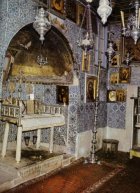 The chapel of the burning bush is the oldest shrine in the monastery which is located on the eastern side of the basilica. Here arose the first community of Sinai hermits. Here once was the burning bush, but later it was placed outside the chapel behind a protective wall. Pilgrims enter this holy place without shoes, as God demanded of Moses (Exodus 3:5). The chapel of the burning bush is the oldest shrine in the monastery which is located on the eastern side of the basilica. Here arose the first community of Sinai hermits. Here once was the burning bush, but later it was placed outside the chapel behind a protective wall. Pilgrims enter this holy place without shoes, as God demanded of Moses (Exodus 3:5).
This chapel distinguish it selves because the altar is not separated from the rest of the chapel and it stands on 4 pillars so pilgrims can kneel and worship at the exact location of the burning bush, where a lamp is always lit. Inside you'll find mosaics on the ceiling, walls of blue and white tiles and covered with a multitude of beautiful icons.
The mosque beside the clock tower is proof of the protection of the monastery by the Egyptian caliphate and also by the monks and their tolerant attitude to Islam. It is a square building with two strong pillars on which the arch and the roof rest. The minaret is opposite the clock tower. The key is entrusted to the Gebeliya Bedouins.
BEDAWI can tell you more about the important relationship between the monastery of St. Katherine and the Bedouins of Sinai.
Traditions regarding the death of the monks are still maintained. There is a cemetery in the garden, with 6 graves. The bodies of the deceased monks stay 5 years in the grave, after which the bones are placed in the ossuary: the crypt of the chapel of St. Tryphon. The skulls are kept in a separate pile in the ossuary. Only the skeletons of important monks get their own niche, like Saint Stefanus.
The sanctuary of Aaron can be seen on the hill left of the road to the monastery. The shrine of the Prophet Aaron (Nabi Arun) lies on the spot where he, according to the Bedouins, stood when he oversaw the making of the Golden Calf. The Bedouins commemorate Nabi Arun with a white tomb. The larger chapel (restored in 1911) is much older and is dedicated in memory of Aaron who was consecrated in the tabernacle on this hill, founded by Moses.
The mold of the Golden Calf can be seen on your right of te road to the monastery. It is an half eroded impression in the rock in the shape of a calf of which the monks said that it was used by Aaron.
The Monastery of St. Katherine is an active Orthodox Christian monastery.
Out of respect for the people and the sanctuaries it is important that you behave and dress properly, i.e. no shorts and your upper body covered.
NB. This goes for men and women.
The city of St. Katherine is approximately 1600 meter above sea level, at the foot of the High Mountains of Sinai. Most tourists stay here no longer than 12 hours. They visit the monastery as a daytrip from Dahab or Sharm el Sheikh and/or climb Mount Sinai and then immediately return. They do not realize what they missed. This region has much more to offer than just the spectacular sunrise and sunset on the Mountain of Moses and the famous monastery...
What can I expect when visiting the monastery?
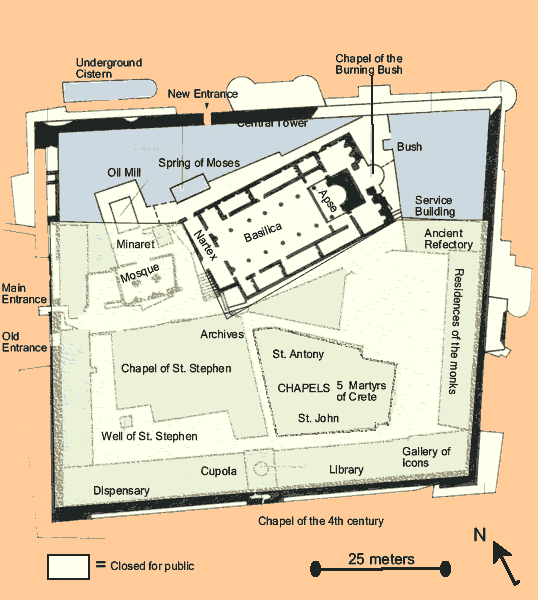
In recent years there has been a huge increase in visitors (buses full of tourists from Sharm el Sheikh, Dahab and Cairo) who all need to see everything in the monastery in 3 hours time. The monastery was not built for this and this bustle leads to abuse which causes a great deal of stress for the monks, the pilgrims and eventually the visitors. There are now a measures taken that information by guides may be given outside the church only and visitors should proceed silently in the church and need to keep walking once they are inside. There is poor light in the church so it's handy to bring a flashlight if you would like to have a good look at the icons inside the church. Furthermore, most places are now closed to visitors (due to inproper behaviour of tourists) and one part is today closed due to restoration work.
The monastery is open Saturdays and Mondays to Thursdays from 8:30 - 11:30 and Fridays from 10:30 - 11:30. It is closed on Sundays and Orthodox Christian holidays.
Information about the Orthodox Christian holidays can be found HERE.
BEDAWI can ask the leadership of the monastery whether there is a possibility for the genuinely interested religious guests to visit the monastery and include a prayer service, however it can not be guaranteed.
These are several possibilities to go from the ECO LODGE to the Monastery of Saint Katherine:
- Walking through nature (2½ to 4 hours) with a Bedouin guide;
- Riding on a camel (approx. 1½ hour) with the owner of the camel as your local guide;
- By 4x4 car, which is faster so you will have more time to combine the visit the monastery with other attractions and/or activities such as a visit to local projects, the visitors centre of the SAINT KATHERINE'S PROTECTORATE and a walk to WADI ARBAI'IN;
- A combination of these possibilities.
|
MONASTERY OF SAINT KATHERINE |
Price p.p. |
|
Entrance to the monastery |
For Free |
|
Entrance Fee to the icon gallery |
Price p.p. |
|
Entrance to the icons gallery |
US $ 5,00 |
|
Children < 12 years |
For Free |
|
Reduction for students (show your student ID/card) |
|
|
FROM THE ECO LODGE |
Price per day |
|
Walking with a local guide, max. 4 hours |
€ 17,00 |
|
|
Price per camel |
|
Rent camel (local guide is included) ca. 1,5 hour |
€ 17,00 |
|
TRANSFER BY 4X4 |
Price per car |
|
4x4 Jeep (4 pers.) return same day, in the region |
€ 25,00 |
|
4x4 Jeep (4 pers.) one way, in the region |
€ 20,00 |
* Snacks or beverages in Saint Katherine are not included.
We hope that the information on our website has stimulated your appetite to travel in our Sinai and we hope to see you soon...
|